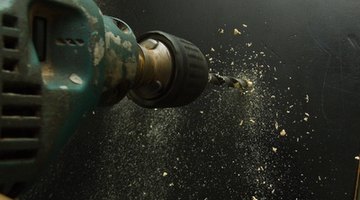How to Seal Screws
The most obvious, convenient and economical way to seal screws is to use manufactured self-sealing screws and fasteners. These are available at most hardware stores and are used to seal metal-to-metal, metal-to-wood and metal-to-just about any material you can imagine to prevent the escape of air, water and gas. If you're a die hard do-it-yourselfer you can create a sealing screw yourself.
Metal-to-Metal

-
Drill a hole through the materials you want to join. Drill the appropriate size hole for the screw.
-
Apply an anaerobic screw thread locking sealant evenly onto the threads of the screw if screwing metal or metal alloys together. There are a variety of thread locking sealants on the market at most hardware stores. Read the description on each label to see which best fits your needs. Use a small brush if necessary to evenly coat the threads.
-
Give the thread locking sealant at least 8 hours to partially cure and 24 hours to fully cure. This will both lock the screw in place when fully cured and protect against vibration since the sealant will not only glue the screw in place but act as a shock absorber between the metal screw and the metal to which it is attached. The better locking sealants will require at least 30 foot-pounds of torque to break the seal, often more when fully set.
Wood-to-Wood
-
Drill a hole through the materials you want to join, making certain to use the correct size drill bit for the size screw you will be using.
-
Mix the epoxy resin with the hardener on a piece of cardboard or small disposable plastic container using a scrap piece of wood.
-
Fill the holes in both pieces of wood with flexible epoxy sealant. There are many brands available at hardware stores so read the labels to make certain you get the best type for your application.
-
Apply the epoxy sealant to the threads of the screw and screw it into place, securely seating the screw. There will likely be seepage of the epoxy sealant from the drilled holes. Use a putty knife to scrape away any excess and a dry clean cloth for whatever epoxy remains on the surface.
-
Apply a bead of epoxy sealant around the edges of the screw head if it is a round screw head. Apply the sealant over the top and around the edges of flat head screws. If the wood is sufficiently heavy, turn the screw into the wood an extra 1/32 of an inch and then cover with epoxy and smooth even with the wood surface using the putty knife.
References
Tips
- The epoxy sealant can be used for many materials in addition to wood. It is suitable for use with ceramics, fiberglass and other materials. The thread locking sealant is used mostly for metal-to-metal applications like duct work or automobile applications.
- The epoxy will begin to harden within 20 minutes so mix in small amounts that are useable within that time.
- The metal-to-metal and wood-to-wood examples are but two of many applications for screw sealing, from interior work in your bathroom to working on roof spouting.
Writer Bio
Chuck Ayers began writing professionally in 1982, breathing life into obituaries, becoming a political and investigative reporter at a major East Coast metropolitan newspaper. He now freelances and is a California communications and political consultant. He graduated from American University, Washington, D.C., with degrees in political science and economics.
Photo Credits
- drill machine macro - hi-speed photo image by .shock from Fotolia.com
More Articles



